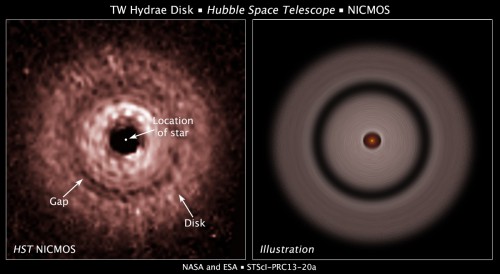
Astronomers analyzing data from NASA’s Hubble Space Telescope have found evidence of a planet forming 7.5 billion miles away from its closest star, which challenges current theories about planetary formation. The suspected planet is orbiting the red dwarf TW Hydrae, located 176 light-years away from Earth in the constellation Hydra the Sea Serpent. Out of 900 confirmed planets found outside our own Solar System, this is the farthest one to be found this far from its star.
Hubble detected a gap in the protoplanetary disk of dust and gas around TW Hydrae, which is 1.9 billion miles wide (the disk is 41 billion miles wide). This gap is believed to have been caused by a planet’s formation, as its gravitational pull “scoops up” material within the disk. The planet is suspected to be six to 28 times more massive than Earth and has a wide orbit, meaning it is moving slowly around its star; to put things into perspective, if the planet was part of our Solar System, it would be approximately twice Pluto’s distance from the Sun.
Making this more interesting is that TW Hydrae is 8 million years old, a relatively young age for a star, making it less likely to foster planet growth. Also, the star is about 55 percent the size of our own Sun. An alternative planet-formation theory suggests that part of the disk may have collapsed producing the gap, making it possible for planets to form in an accelerated time period (thousands of years). John Debes of the Space Telescope Science Institute in Baltimore, Md., leads the research team that identified the gap.
“It’s so intriguing to see a system like this. This is the lowest-mass star for which we’ve observed a gap so far out … If we can actually confirm that there’s a planet there, we can connect its characteristics to measurements of the gap properties. That might add to planet formation theories as to how you can actually form a planet very far out.”
The researchers used Hubble’s Near-Infrared Camera and Multi-Object Spectrometer (NICMOS) to observe the star, then compared those images with archival Hubble data and findings from the space telescope’s Space Telescope Imaging Spectrograph (STIS). Debes reported that researchers saw the gap at all wavelengths. The researchers’ findings will appear in the June 14 edition of the Astrophysical Journal.
Want to keep up-to-date with all things space? Be sure to “Like” AmericaSpace on Facebook and follow us on Twitter:@AmericaSpace




One Comment
One Ping
Pingback:Hubble Telescope Reveals Evidence of Farthest Known Planet From Its Star | EYES! On News